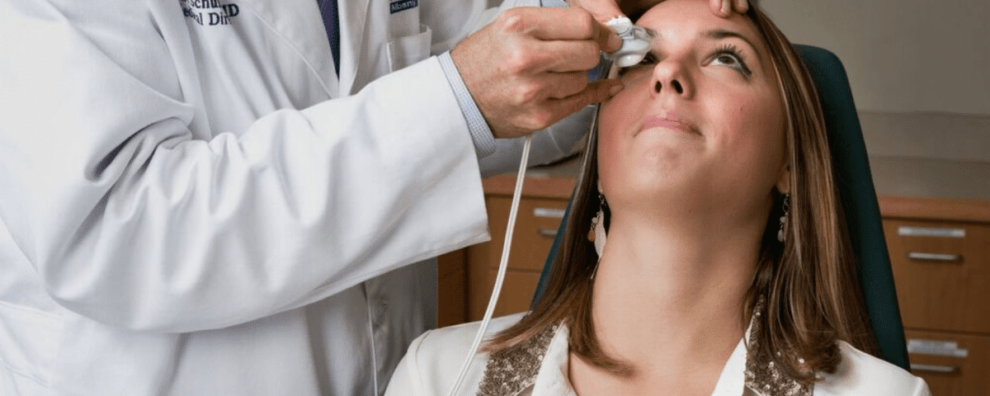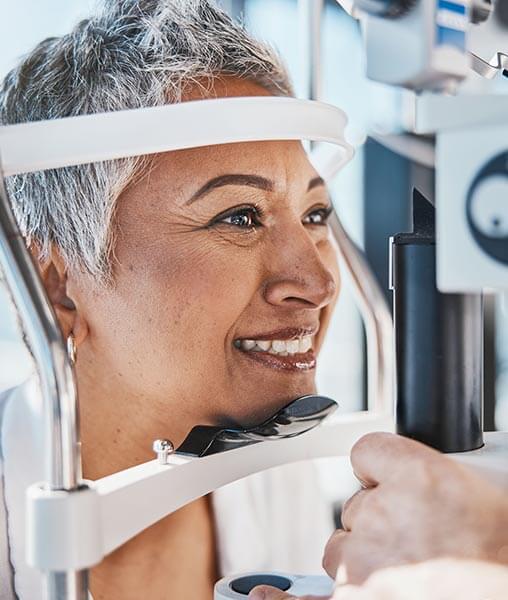Posted by: Albany Cornea | Center For Eye Care Excellence in Uncategorized

Dry eye syndrome affects millions of people, causing vision problems and a lot of discomfort. Stinging and burning sensations from dry eyes can also distract you from the visual pleasures around you, as well as make it difficult to accomplish daily activities. This syndrome can be caused by a variety of common things: allergies, prolonged contact use, straining your eyes, and so on. With dry eye syndrome, your eyes don’t produce the correct amount of tears, which is necessary for maintaining healthy eyes. Besides providing lubrication and nourishment, tears also keep the eyes clean by washing out the cornea (the surface of the eye) and keeping it clear of objects. If dry eye is not diagnosed early enough, it can severely damage the cornea, which can lead to other issues that are more difficult to treat. Dry eye syndrome is very common, but by diagnosing it and treating it early we can prevent most of the discomfort associated with the condition.
Symptoms
Surprisingly, given its name, dry eye often causes excessive tearing and watery eyes. This is because dry eye is caused by an interruption in tear production. Tears are what lubricate the eyes, but this excessive tearing lubricates the eyes too much and causes them to produce fewer and fewer tears, which ultimately dries out the eyes.
As dry eye syndrome progresses, you will likely notice that your eyes appear to be whiter or slightly redder than normal. You will also notice a sandy or gritty feeling, as though something is in your eye that you can’t get out. This feeling is caused because the eyes are not getting enough lubrication. You may notice sensitivity to light as well. The dryness of your eyes will also make contact lens use uncomfortable. Your eyes will likely feel irritated, painful, and tired, so schedule an appointment with Center For Eye Care Excellence as soon as possible if you are noticing any of these symptoms or any other disruptions to your vision.
Causes
Dry eye syndrome is one of the most common disorders that affect the front of your eye, which includes the cornea, iris, and lens. All of these parts of the eye are essential in producing a clear image. Because these parts are on the outer eye, they are more susceptible to wear and tear, and this wear and tear often leads to dry eye. The syndrome can be caused by a variety of things, including:
Environment – Exposure to smoke, wind, dust, and dry climates can evaporate your tears, drying out your eyes.
Medication – Antihistamines, decongestants, blood pressure medications, and antidepressants can interrupt tear production.
Medical Conditions – Certain conditions like rheumatoid arthritis, diabetes or thyroid problems can put you at a greater risk of getting dry eye syndrome.
Gender – Women are more likely to experience dry eye syndrome because of hormonal changes that occur during pregnancy, menopause, or from the use of oral contraceptives.
Eyelid Shape – Because dry eye affects the outer eye, inflammation or problems with the eyelids and the surfaces of the eye can also increase risks of getting dry eye, especially if your eyelids turn inward or outward.
Screens –Staring at TVs, laptops, and cell phones for extended periods of time and failing to blink often.
Previous Surgeries – Oftentimes, treatment or surgery for other eye conditions can lead to dry eye. Dry eye caused by surgery is often temporary and much more mild than other forms.
Age – Dry eyes are also a part of the aging process. The majority of people over the age of 65 will experience some form of dry eye syndrome.
Who is most likely to get dry eye?
Dry eye is one of those conditions that tend to cause problems as we age, which is why it is very common for people over the age of 65 to be diagnosed with dry eye syndrome. Gender can also be factor in getting dry eye. Because of hormonal changes from pregnancy, taking oral contraceptives, and menopause, women are more likely to suffer from dry eyes. People who have undergone refractive eye surgeries, or use contacts, are also more likely to get dry eye. If you are experiencing dry eye after a procedure, the condition will likely be temporary and only last for a few weeks or months. If you fall into one of the above categories, make sure you maintain regular eye appointments so that any signs of dry eye syndrome can be caught as soon as possible.
Treatment
Dry eye is often a chronic condition and is not easily cured, but there are many treatments available that will help lubricate your eyes, keeping them safe and making you more comfortable. There are a few treatments you can do at home to help your comfort, but prescription eye drops are the most common and best treatment available for dry eye.
Home treatments:
Use a humidifier in your bedroom and other rooms that you use often to reduce your eye’s exposure to dry environments.
Wear glasses that wrap around the edges of your eyes when you’re doing outdoor activities like golfing, skiing, hiking, or working in the yard to protect your eyes from harmful environments.
Use over-the-counter eye drops for immediate comfort, but understand that they are only a quick fix and may contribute to the drying out of your eyes if they are used too often.
While these home treatments can help with comfort, prescription artificial tears are your best bet to prevent the harmful effects of dry eye syndrome.
Prescription eye drops:
Prescription strength artificial tears are able to re-lubricate the eyes to bring you relief without drying your eyes out after their use. If you are experiencing severe dry eyes, we can temporarily or even permanently close the tear drain so that your eyes begin producing the correct amount of tears again. This technique takes a simple surgery where we insert a silicone plug into the tear duct to try and train your eyes to produce sufficient tears. If the silicone plugs work well we can insert a more permanent plug, which should help your eyes produce the right amount of tears.
Autologous Serum eye drops:
Autologous Serum eye drops are a special kind of prescription eye drop made from blood serum. Blood serum is what is left after red blood cells and clotting agents are removed from blood, and it produces a tear substitute that is unique to each patient. Your blood serum contains many of the same nutrients and growth factors found in healthy tears, and it has the identical salinity and pH level as your tears. This means that there will be no stinging or burning when you put the eye drops in your eyes. It is very easy and simple for you to receive these unique eye drops; after you have your blood drawn it is sent to the nearest pharmacy, and they will have your eye drops finished within just a couple of hours. Because Autologous Serum eye drops are created specially for each patient, they can increase treatment comfort for dry eye syndrome.
Prokera:
Prokera is a therapeutic treatment designed to repair the surface of the eye, which can help normalize tear production in your eyes. Prokera helps minimize corneal scarring, controls inflammation, and promotes healing in the cornea. It works like a bandage; a lens is created from human amniotic membrane contained in a thermoplastic ring set, and this lens is placed in the eye to remain there for about 1 to 2 weeks before it is removed. The amniotic membrane is what protects a baby in the womb during pregnancy, and it has natural therapeutic and healing properties. For dry eye, a very thin lens called the Prokera Slim is placed in your eye so you will remain perfectly comfortable and will hardly notice the lens throughout the duration of treatment.
LipiView and LipiFlow:
LipiView is a brand new technique that allows us to better examine the thickness of the lipid (a type of oil) layer on your eyes’ tear film. Lipids are necessary for the tear film to produce tears, so a lipid deficiency is one of the many causes of dry eye. The LipiView Ocular Surface Interferometer is the first technology that helps us see if you are lipid deficient. Using this latest technology, we can better prescribe a treatment for your dry eye. With the many different treatment options available, LipiView helps us to find the right treatment on the first try. Measuring your lipid levels with LipiView is a very simple procedure. It takes only 5 minutes, and all you have to do is look into a special camera and blink. If LipiView shows a lipid deficiency, we can begin using LipiFlow to help improve your dry eye syndrome.
LipiFlow is the most exciting new therapy offered to treat a form of dry eye known as “evaporative dry eye.” Evaporative dry eye is caused when Meibomian glands in the eye become blocked. The LipiFlow Thermal Pulsation System uses an eyepiece, called the “activator,” to apply controlled heat to the inside of your eyelid. Using thermal energy and adaptive pressure, this treatment essentially clears the blockage of the Meibomian glands. When the glands are unblocked, they will be able to produce lipids again, which will help your tear film begin producing the correct amount of tears. LipiFlow takes only 1 session in our office, and most of our patients experience relief from dry eye in 2 weeks.
LipiView and LipiFlow are the absolute latest techniques in dry eye syndrome treatment. Center For Eye Care Excellence is one of the only practices in the area to offer these specialized technologies to our patients, so that we can ensure every member of the Center For Eye Care Excellence family sees comfortably.
Center For Eye Care Excellence is always researching newer and better ways to treat dry eye syndrome. Recently, we participated in FDA trials that led to the approval of one of the most successful eye drops to treat dry eye—Restasis. Restasis helps your body to create more of its own tears, so you don’t have to rely only on artificial tears. There are even some cases in which we can use components from the natural serum in your own eye to ensure there is enough lubrication. Dry eye syndrome can be an extremely uncomfortable condition that inhibits quality of life, so we continue to work toward our goal of eliminating symptoms of dry eye and finding an even better solution to the condition.

